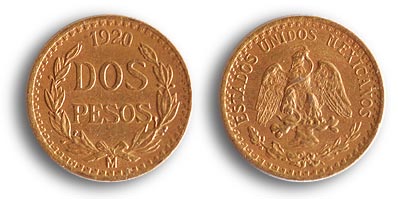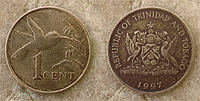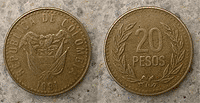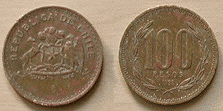Mexican Gold Coin Dos Pesos
We met a friend of ours early Saturday morning at a beach. It was nice out and the tide was low. Our friend and I started checking some new cuts in the beach, and Carol was checking the low tide line.She was using the XLT in Jewelry/Beach mode because the place is so trashed. She found a marble rolling in the surf right off. She said when she got this target it was a straight 22 and it said foil. She dug in about 4 inches and then plopped the wet sand near her and rescanned it.
 It was a tiny broken signal she was looking for. She moved the sand with her fingers and saw it. Thinking it was a token she slipped it into her pouch, yet she thought it strange that it was so tiny. When we took a break later, we were comparing our finds and this was the last thing she showed me. It was way in the bottom corner of her pouch.
It was a tiny broken signal she was looking for. She moved the sand with her fingers and saw it. Thinking it was a token she slipped it into her pouch, yet she thought it strange that it was so tiny. When we took a break later, we were comparing our finds and this was the last thing she showed me. It was way in the bottom corner of her pouch.
I said, Let me see that, it's gold, you found a gold coin! I handed it back to her and all of a sudden, a dog belonging to someone walking on the beach, ran over to Carol wagging his tail and jumping all over her and licking her face! I thought she was going to lose the coin! But she had it between her thumb and first finger, holding it tightly.
The owner apologized, and we told her it was okay. She said, Thanks for not getting mad. But, who can get mad at anything when you just found a gold coin? Congratulations honey, you're now a member of the Gold Coin club. (XLT/Jewelry/beach mode)
Republic of Trinidad and Tobago
 We found this little foreign coin at a beach here in CT and it was raining all day. When it rains, that's is the best time to go to the beach because hardly anybody shows up. We also found our first half dollar, a Kennedy. That was a real shocker, considering we had only had the detector for 7 days!
We found this little foreign coin at a beach here in CT and it was raining all day. When it rains, that's is the best time to go to the beach because hardly anybody shows up. We also found our first half dollar, a Kennedy. That was a real shocker, considering we had only had the detector for 7 days!
History: These islands in the British West Indies were discovered by Columbus and settled by the Spanish, who ceded them to Great Britian in 1802. They became one colony in 1889 and an independent member state of the British Commonwealth in 1962. (XLT/Relic mode)
Republica De Colombia 20 Pesos Coin
 We found this coin on the same day as the British coin. So cool, a 1991 20 pesos coin. We're always happy finding foreign coins, even if they're not old. I wonder how in the world they got there! Somebody dropped them, right? (XLT/relic mode)
We found this coin on the same day as the British coin. So cool, a 1991 20 pesos coin. We're always happy finding foreign coins, even if they're not old. I wonder how in the world they got there! Somebody dropped them, right? (XLT/relic mode)
History:The Republic of Colombia is located in NW South America. Bogotá is the capital and largest city. It is the only South American country with both a Caribbean and a Pacific coastline.
Colombia has both torrid jungles and majestic, snowcapped mountains. Oil replaced coffee as the nation's leading legal export in 1991. During the early 1990s the economy was growing quickly in comparison with that of other Latin American countries, and inflation and unemployment were under control. However, government spending and foreign debt soared in the late 1990s, and labor unrest and internal problems related to the drug trade continued to threaten the country's economic stability.
Republica de Chile Pesos Coin
 A 100 pesos coin from Chile. Not old, but cool. The year is 1996. It was also found by my wife about a foot from the bank at one of our old spots. She was using relic mode and pulling just about everything. But she said even the wheaties she found were giving off strange, broken signals. There's very few beaches that we can search in relic mode without a lot of interference.
A 100 pesos coin from Chile. Not old, but cool. The year is 1996. It was also found by my wife about a foot from the bank at one of our old spots. She was using relic mode and pulling just about everything. But she said even the wheaties she found were giving off strange, broken signals. There's very few beaches that we can search in relic mode without a lot of interference.
Early History: Before the arrival of the Spanish in the 16th cent., the Araucanians had long been in control of the land in the southern part of the region; in the north, the inhabitants were ruled by the Inca empire.
Diego de Almagro, who was sent by Francisco Pizarro from Peru to explore the southern region, led a party of men through the Andes into the central lowlands of Chile but was unsuccessful (1536) in establishing a foothold there. In 1540, Pedro de Valdivia marched into Chile and, despite stout resistance from the Araucanians, founded Santiago (1541) and later established La Serena, Concepción, and Valdivia.
After an initial period of incessant warfare with the natives, the Spanish succeeded in subjugating the indigenous population.
Although Chile was unattractive to the Spanish because of its isolation from Peru to the north and its lack of precious metals (copper was discovered much later), the Spanish developed a pastoral society there based on large ranches and haciendas worked by indigenous people; the yields were shipped to Peru.
During the long colonial era, the mestizos became a tenant farmer class, called inquilinos; although technically free, most were in practice bound to the soil. (XLT/relic mode)
1886 Rep. de Colombia 5 Centavos
 This is the oldest of our foreign coin collection, except for one we can't identify. This Republic of Colombia coin was found on a sandy path that the rain made a cut in. We were hunting with our club in a State Park in RI. (XLT/relic mode)
This is the oldest of our foreign coin collection, except for one we can't identify. This Republic of Colombia coin was found on a sandy path that the rain made a cut in. We were hunting with our club in a State Park in RI. (XLT/relic mode)
History: The History of Colombia is a very colorful one. Prior to the Spanish conquest, Colombia was inhabited by Chibcha, sub-Andean, and Caribbean peoples, all of whom lived in organized, agriculturally based communities.
After the Spanish conquest, which began in 1525, the area of present-day Colombia formed the nucleus of New Granada. The struggle for independence began in 1810, and by 1830 Venezuela and Ecuador had seceded, and the remnant (Colombia and Panama) was renamed the Republic of New Granada. This became the Republic of Colombia in 1886, from which the present Panama seceded in 1903.